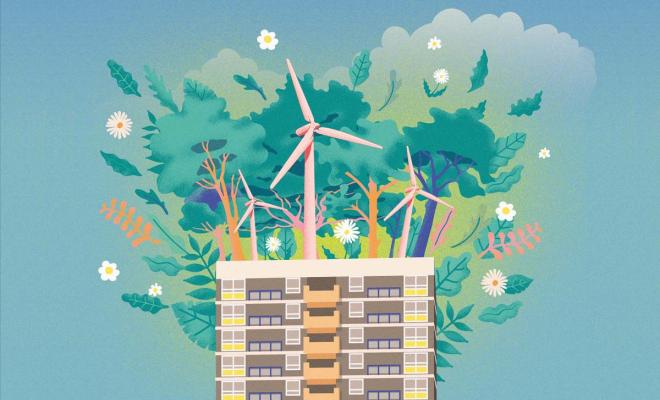30 Apr 2024
How is Action 29 tackling the climate crisis?
The climate benefits of renewable energy are well-known. The government has set targets for increasing offshore wind generation, but the UK needs more onshore wind and solar too. Onshore wind sites must be allocated through the planning process alongside other land designations in Local Plans (and in Local Development Orders, Neighbourhood Development Orders and Community Right to Build Orders).
Stroud District Council has put carbon neutrality by 2030 at the heart of its plans for the area, including a focus on renewable energy. National planning policy doesn’t fully support onshore wind, but Stroud District Council is taking a proactive approach. It's one of the few local authorities encouraging new wind and solar installations by identifying opportunities in the area as part of its Local Plan, although these potential areas, and the proposals within them, are still subject to other policies included in the Plan.
Renewable energy growth is explicitly linked to carbon neutrality in the authority’s most recent draft Local Plan, which is still under examination by the Planning Inspectorate.
Delivery policy ES2 outlines criteria for the development of renewable schemes, including:
- Developments are likely to be successful if they're in areas identified by the council as suitable for wind or solar in its "policies map". This identifies all land with the technical potential for renewables.
- Developers of renewable energy schemes should engage with local communities as early in their projects as possible. Support will be given to proposals that are led by or meet the needs of local people.
How Stroud’s policy encourages more onshore wind while complying with national policy
Identifying all land in the district with the technical potential for renewables was a key aim of the policy. Doing so ensures that onshore wind proposals are compliant with the National Planning Policy Framework (NPPF) without limiting the potential for onshore wind.
Despite recent updates to the NPPF, there are specific tight restrictions on wind development that don’t apply to other energy infrastructure. For example, onshore wind energy projects must be in an area formally identified as “suitable” by a Local or Neighbourhood Plan or a supplementary planning document. Wind proposals also need to demonstrate the “support” of communities to a higher bar than is set for other developments, including fossil fuel extraction. To date, few Local Plans have proactively allocated sites for onshore wind, and the situation is unlikely to change under the tweaked national policy (see more detail below). Site suitability is more flexible for solar than for wind.
In order to ensure NPPF compliance, Stroud District Council made sure it would have evidence to back its policy. In 2019 it commissioned the Centre for Sustainable Energy and Land Use Consultants to assess renewable energy opportunities within Stroud, including various scenario models up to 2040.
The result was a survey of all the potentially viable sites in the district. This functions as a technical evidence base underpinning the Local Plan. Without this assessment, the crucial policies map included in the Local Plan wouldn't have been possible, significantly limiting wind expansion.
Some sites need special consideration. Proposals within the Cotswolds Area of Outstanding Natural Beauty and the Severn Estuary will be considered, but only where the benefits of the development can demonstrably outweigh its harms.
The council can now legally boost both standalone wind and solar generation in the district, subject to public examination and inspection.
What impact has the project had?
Stroud’s Renewable Energy Resources Assessment noted that, as of June 2019, about 12% of the energy produced within Stroud was from renewable sources. The council’s 2030 Strategy Master Plan, adopted in 2021, sets out the context, rationale and approach for tackling climate and ecological challenges. One of the strategic goals included in the Master Plan seeks to at least triple the proportion of renewable energy generation within the district from the current level of 12%.
For each type of renewable energy, the assessment identified what schemes (both community-owned and commercial) currently exist across the district, and what projects have received approval for future development.
Wind
- Four wind turbines are already in operation and generating a total of 3.5 MW of energy (Sharpness Docs, Lynch Knoll, and 2 at Mountenays and Cherry Rock).
- There's technical capacity for wind generation of up to 336 MW in the district, saving an estimated 198,017 tonnes of CO2 emissions a year.
- The greatest potential for future expansion of wind energy in Stroud is through small and mid-sized wind turbines.
- Three wind developments have received approval in the district: Partnership for Renewables turbine at Sharpness, 2 Resilient Energy turbines under a community benefit society model, and Ecotricity’s new Alveston wind park.
Solar
The assessment identified 7 ground-mounted solar projects that had either received consent or were already installed, with a total capacity of at least 68.4 MW.
In July 2023 Stroud approved a new 160-acre solar farm to be developed by British Solar Renewables Energy at Berkeley. The farm will be 50 MW and have the capacity to power 12,500 homes.
Hydropower
The assessment found Stroud has little capacity for hydropower, although historically the Stroud Valleys were powered by watermills. There may be limited opportunities for hydroelectric schemes in and around these mills.
What made this work?
Cross-party political consensus
Stroud District Council is governed by an alliance of Labour, Liberal Democrat and Green councillors, all of whom backed the focus on renewable energy in the Local Plan.
Strategic support
The council’s Strategic Head of Development Services was also highly enthusiastic and had detailed knowledge of the ins and outs of the NPPF to make the expansion of renewables in Stroud feasible.
Youth involvement
From 2017 onwards the council worked with Stroud Youth Council on the Local Plan. Young people made it clear that renewable energy was a key priority for them.
Partnering with the Youth Council was a deliberate decision by the council to develop the skills of Stroud’s future leaders, with a view to ensuring long-term consistency in decision making.
Community support and demand
Stroud District Council received several queries from parish councils wishing to explore opportunities for community renewable energy generation, inspired to support the council’s 2030 ambition.
Support for the policy was also demonstrated during the consultation process for the Local Plan. Policy ES2 encouraging renewable energy received just one formal objection, which was much lower than for many other proposed policies.
Overall, Stroud had significant demand for renewable energy generation at all levels, including from councillors, directors, officers, communities and young people.
Local assets
One of the biggest employers in the district is Ecotricity, a renewable energy generation company that builds wind turbines and solar panels. Stroud has existing local assets that would facilitate the expansion of in-district renewable energy generation while also creating jobs for local people. Although this is a big asset for Stroud, most other local authority areas will have local renewable energy companies (at least fitting solar panels).
Evidence base
Stroud’s Renewable Energy Resources Assessment provided an essential evidence base to enable the council to update its Local Plan policy to maximise space for renewables, and especially onshore wind, within the constraints of the NPPF. As a result, Stroud District Council is confident that it's met all the legal obligations required for its ambition to improve the prospects for wind development in the district.
What resources were needed?
Stroud District Council invested in commissioning the Renewable Energy Resources Assessment, which cost £20,000. Occasional input from council officers, particularly the planning strategy team, was necessary during the development of the assessment. Planning officers continue to analyse feedback on new policies and discuss possible modifications, with potential for future updates to evidence bases such as Stroud’s Renewable Energy Resources Assessment.
The council has 3 full-time climate officers and a budget allocated to facilitate its drive towards carbon neutrality by 2030, but consideration of carbon neutrality is present across council services. The council has also worked with the board of the Area of Outstanding Natural Beauty regarding the landscape impact of wind energy proposals.
Besides this, the updating of Local Plans (at least every 5 years) is a statutory requirement for all local authorities. The work to ensure that renewable energy allocation was woven into the Local Plan didn't incur any unexpected financial costs during the updating of the plan.
Lessons from Stroud
National policy is still unhelpful, but can be changed
Stroud developed its strong policy despite the unhelpful approach in the NPPF, but reform at a national level would help all councils to boost onshore wind sites.
Very few local authorities have functional policies for onshore wind, and this is likely to remain the case without further changes to the NPPF. Gathering the necessary evidence to justify suitable sites for renewable allocation is resource intensive, so this policy requirement is absent in many councils’ Local Plans, largely ruling out wind except for the repowering of existing sites.
In December 2023 the government updated the NPPF but did little to ease the restrictions on onshore wind. The changes allow suitable sites for wind to be identified by other methods than a Local Plan. But identifying land in a supplementary planning document is still a resource intensive process and a higher bar than is required for other energy projects. Some requirements have also been lessened, as "acceptability" now depends on planning impacts having been "appropriately addressed" (rather than “fully”), and community “support” is now needed instead of community “backing”. While it’s more positive that onshore wind proposals can no longer be stopped by a single dissenting resident voice, demonstrating “community support” is still a higher bar than for other energy infrastructure including fossil fuels. In reality, it seems there’s little change to the barriers to bringing forward onshore wind developments, at least for now.
The most positive aspect of the changes to the NPPF relates to repowering: replacing older turbines with modern ones that are even more efficient. The government agrees with the industry that this should be encouraged, to stop us losing the onshore wind capacity we already have when projects come to the end of their natural lifespan after generating for 25 years. As a result, such sites don’t have to be identified in suitable areas, and “significant weight” can be given to the benefits of utilising an established site, with a local planning authority able to approve such proposals if their impacts are or can be made “acceptable”.
Overall, the ability of ambitious local authorities like Stroud to exceed the carbon targets of the UK’s binding 2050 deadline is constrained by the lack of progressive national planning policies, which actually hinder rather than facilitate new renewables.
Reform of planning at a national policy level is necessary, and councils should be proactive in seeking reform when the NPPF is reviewed.
“The government’s very slight changes to the planning system aren’t going to bring about a significant increase in the number of new onshore wind farms in England. There are still restrictions to onshore wind that aren’t faced by any other infrastructure – despite widespread cross-party support to end the de facto ban – which is dampening the confidence of investors who would otherwise be interested. Local communities that support onshore wind are being denied the chance to benefit from cheap clean power.”
James Robottom, Head of Policy at RenewablesUK
Restrictions will vary in different locations
Further barriers for other councils might include the proximity of potential sites to national parks, Areas of Outstanding Natural Beauty, green belts or other ecologically important sites (although Stroud’s example shows these can be appropriately accounted for). Sometimes tensions arise between increasing renewable energy generation and conservation concerns. Finding solutions to these is important, which will be facilitated by dialogue with stakeholders and robust evidence about any risks in sensitive locations.
Urban areas may have less available land for standalone renewable energy generation and may need to impose minimum distance restrictions for wind turbines near houses. Community engagement will be important, and sometimes roof-mounted solar may be a better solution in urban settings.
“We were aware early on that we needed to tackle renewable energy generation. After the examination of our 2015 Local Plan, we decided to level up and take this to the next stage in the following plan. This is why the Renewable Energy Resources Assessment was felt to be essential. You can have broad policy statements, but the devil is always in the detail of actual delivery.”
Conrad Moore, Principal Planner at Stroud District Council
Useful information
To find out more, contact Stroud’s planning strategy team.
Read Stroud’s draft Local Plan and the Renewable Energy Resources Assessment.
See Stroud's maps of suitable areas for renewable energy and landscape sensitivity to renewable energy development.
Related projects
Other councils are assessing the potential for renewable energy in their areas, with a view to including renewables policies in their Local Plans.
- Bath and North East Somerset Council, alongside other local authorities, has commissioned a Renewable Energy Resource Assessment Study.
- Lancaster City Council is assessing the potential opportunities for wind energy generation in its Full Local Plan Review.
Friends of the Earth's view
Not enough councils are identifying sites for renewable energy, especially for onshore wind. Unsupportive and confusing national planning policies as well as delays in connecting to the national electricity grid aren't helping. So it’s encouraging that Stroud District Council has developed a proactive and evidence-based policy to boost renewables that complies with the NPPF.
Hopefully, more councils will be bolder in allocating the space that is urgently needed to increase onshore wind generation. To help them, researchers at Exeter University’s Environmental Intelligence Centre and Friends of the Earth have identified the most suitable land for onshore renewables, taking into account grid connections as well as protecting nature, important landscapes and the best agricultural land.
Councils should also require renewable energy such as solar panels or heat pumps in new developments (Action 32 of the Climate Action Plan).
Friends of the Earth is showcasing specific examples of good practice in tackling climate change, but that doesn’t mean we endorse everything that a council is doing
This case study was produced by Ashden and Friends of the Earth. It was originally published in March 2022 and was last updated in April 2024.





